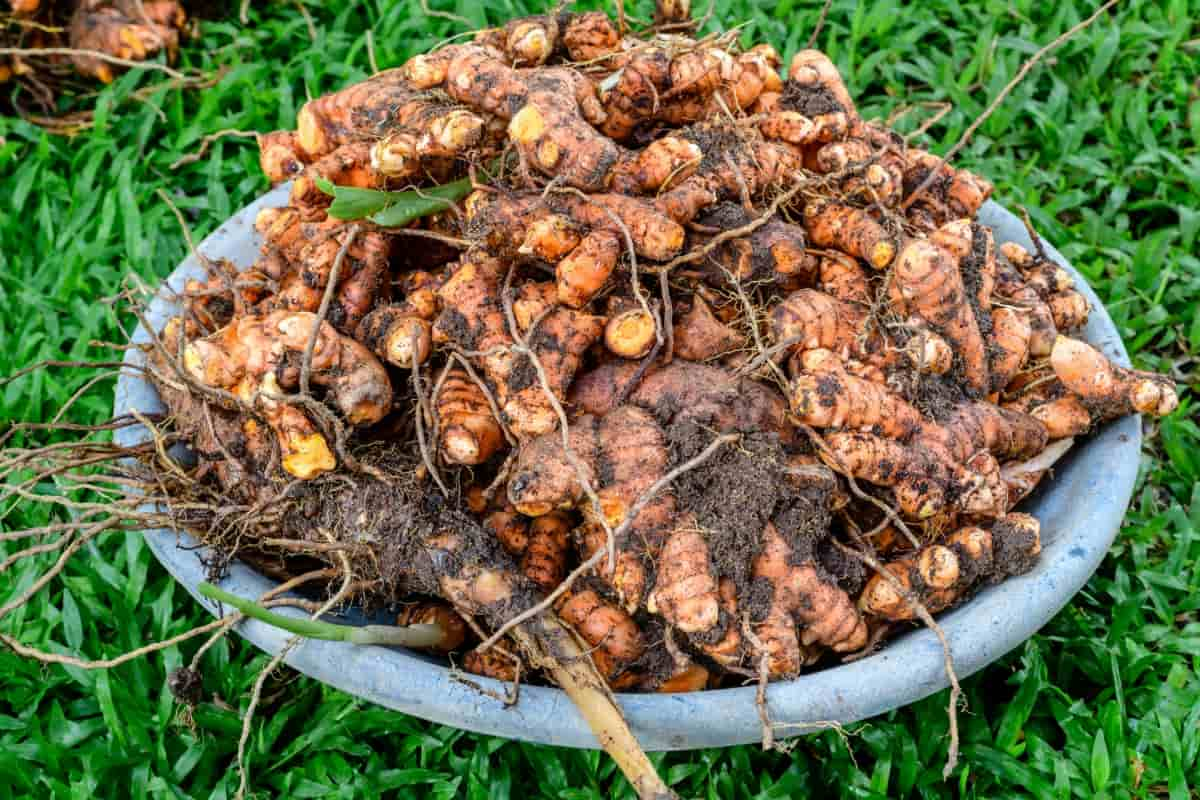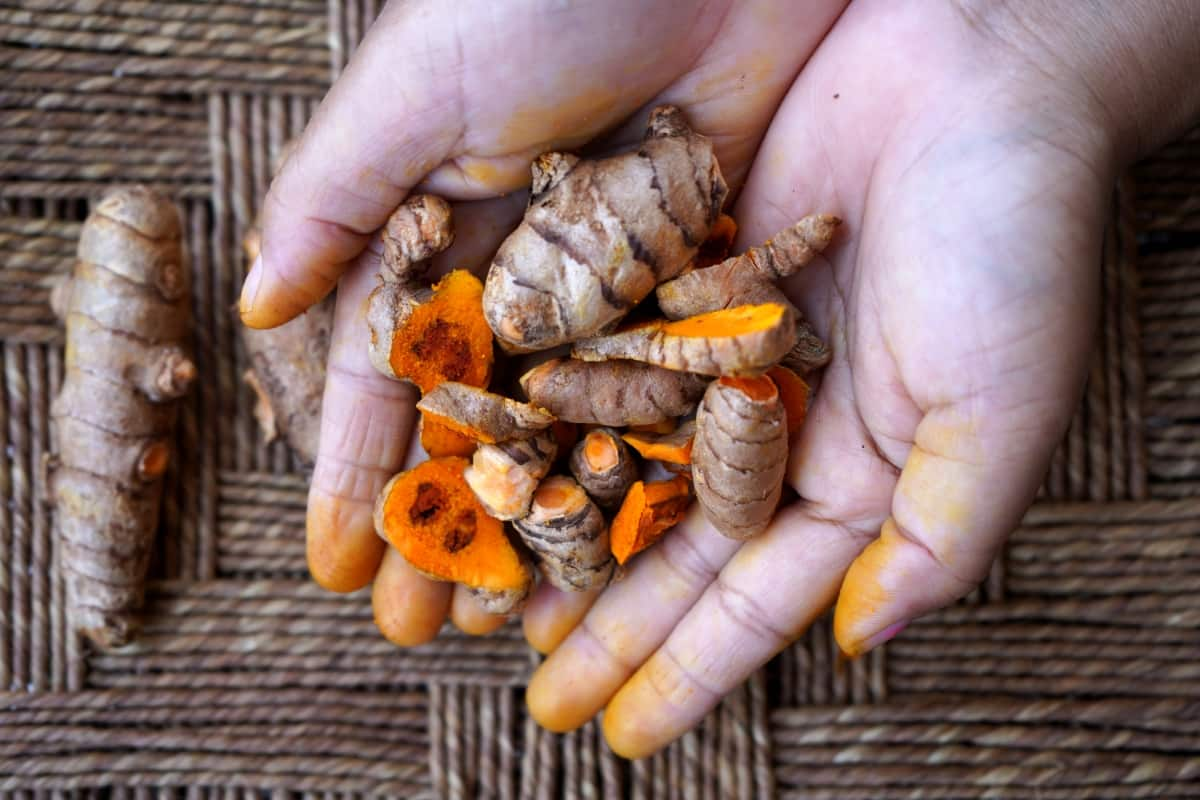Turmeric farming plays a crucial role in the agricultural sector due to its various benefits and uses. Not only is Turmeric a staple ingredient in many cuisines worldwide, but it also holds significant medicinal properties. The demand for Turmeric and its by-products continues to rise, creating opportunities for farmers to generate income and contribute to economic growth.

Botanical Profile of Turmeric
Turmeric, scientifically known as Curcuma longa and belonging to the Zingiberaceae family, is a fascinating plant with a rich botanical profile. With its vibrant yellow-orange rhizomes and lush green leaves, Turmeric adds not only flavor but also color to dishes around the world. This herbaceous plant can grow up to 1 meter in height and thrives in tropical climates. The flowers of the Turmeric plant are a sight to behold, with their cone-like spikes boasting shades of white or pink. It’s intriguing how such an unassuming plant holds so much potential for culinary and medicinal purposes.
Climate and Soil Requirements
Turmeric farming thrives in warm and humid climates. It needs a temperature of 20-30°C to grow successfully. The plant also needs well-draining soil rich in organic matter and a soil pH level between 5.5 and 7.5. Loamy or sandy loam soil works best for Turmeric cultivation. Avoid waterlogged areas, as they can lead to root rot and other diseases.
Turmeric plants do not tolerate frost, so it’s essential to plant them at the right time, according to your region’s climate. When it comes to soil fertility, adding compost or well-decomposed manure before planting can significantly improve yield. Regularly testing the soil for nutrient levels helps ensure the plants have everything they need to thrive.
Land Preparation and Soil Fertility Management
Land preparation is a crucial aspect that can significantly impact the success of your crop. Before planting Turmeric, make sure to prepare the land by removing any weeds and debris. Soil fertility is key in ensuring healthy plant growth and high yields. Conduct soil tests to determine if any nutrients are lacking and amend the soil accordingly with organic matter or fertilizers. Maintaining proper soil pH levels is also important for optimal Turmeric growth.
In case you missed it: Turmeric Farming, Planting, Care, Harvsting Guide

Turmeric Varieties
Turmeric varieties vary in their characteristics, such as yield potential, disease resistance, and flavor profile. Some popular varieties include Alleppey Finger, Erode Local, Rajapore, and Sangli Pasand. Each variety has unique traits that cater to different growing conditions and end uses. Alleppey Finger Turmeric is known for its high curcumin content, making it ideal for medicinal purposes and spice production.
Erode Local variety is favored for its strong aroma and bold flavor profile in culinary applications. Sangli Pasand stands out for its adaptability to various soil types and climates. Farmers carefully consider their specific needs and growing conditions when selecting a Turmeric variety to cultivate.
Propagation Methods
Turmeric propagation methods are crucial in ensuring a successful harvest. One common method is rhizome division, in which healthy rhizomes are carefully separated to be replanted. Another effective technique is tissue culture, which involves growing Turmeric plantlets in a controlled environment before transferring them to the field.
Rhizome cutting is also popular among farmers. Sections of the rhizome with at least one bud are used for planting, allowing multiple plants to be grown from a single rhizome. Additionally, some growers opt for seed propagation, although it is less commonly used due to lower success rates compared to other methods.
Planting and Spacing Guidelines
Before planting Turmeric, the soil is rich in organic matter and free from pests or diseases that can harm the crop. Plant the rhizomes about 5-7 cm deep into the soil with adequate spacing between each plant. The recommended spacing between Turmeric plants is around 30-45 cm apart in rows that are about 45-60 cm apart. Proper spacing promotes better air circulation, which in turn makes it easier to manage weeds and apply fertilizers effectively throughout the growing season.
In case you missed it: Growing Turmeric In Pots, Containers, Indoors

Irrigation and Water Management
Turmeric plants require consistent moisture to thrive, especially during the initial stages of growth. Adequate watering is essential to ensure proper root development and nutrient absorption. Drip irrigation systems are highly recommended for Turmeric farming. Drip irrigation helps in delivering water directly to the roots, minimizing water wastage and ensuring efficient utilization by the plants.
It also helps in controlling weed growth and reducing disease incidence. Monitoring soil moisture levels regularly is key to optimizing irrigation practices. Adjusting watering based on plant requirements can help prevent both under-watering and over-watering issues that may affect Turmeric yield. Implementing good water management practices not only promotes healthy plant growth but also contributes to higher yields during harvest time.
Nutrient Management
Ensuring proper nutrient management is crucial in Turmeric farming to achieve optimal growth and yield. Turmeric plants require essential nutrients like nitrogen, phosphorus, potassium, and micronutrients for healthy development. Soil testing is key to determining the specific nutrient requirements of your Turmeric crop. Based on the results, you can apply organic manures or fertilizers to meet these needs.
Maintaining a balanced nutrient supply throughout the plant’s growth stages promotes strong root development and overall plant health. Regular monitoring of soil fertility levels is necessary to adjust nutrient applications as needed. Organic fertilizers can provide the soil with these necessary nutrients. Additionally, micronutrients like iron, zinc, and manganese play vital roles in the overall health of Turmeric plants.
Regular soil testing can help determine any deficiencies that need to be addressed through targeted fertilizer applications. Over-fertilization of the Turmeric plant can lead to potential harm to the environment. It’s important to follow recommended dosage guidelines and adjust based on specific soil conditions. By implementing effective nutrient management practices, farmers can optimize their Turmeric yield and quality sustainably.
Pest and Disease Control
Pests and diseases can affect your Turmeric crop if not properly managed. To ensure a healthy harvest, it’s essential to stay vigilant and proactive in controlling these threats. Pests like rhizome scale, shoot borer, and leaf roller can wreak havoc on Turmeric crops if left unchecked. These pests can cause damage to the Turmeric plant’s leaves and rhizomes, affecting overall yield and quality.
Turmeric is also susceptible to various diseases, such as rhizome rot, leaf blotch, and bacterial wilt. If not properly managed, these diseases can spread quickly through a crop. Implementing integrated pest management practices is crucial in controlling pests and diseases in Turmeric farming.
Crop rotation is an effective method for disrupting pest cycles and reducing disease pressure. Using organic pesticides and fungicides made from natural ingredients can be a sustainable way to combat pests without harming the environment. Implementing integrated pest management strategies that combine cultural, biological, and chemical control methods can provide comprehensive protection for your Turmeric plants.
Weed Management
Weeds compete with Turmeric plants for nutrients, water, and sunlight, affecting their overall yield. To effectively manage weeds in your Turmeric field, regular monitoring is essential. Manual weeding using tools like a hoe or hand pulling can help remove weeds without damaging the Turmeric plants. Herbicides are also used for controlling weeds in Turmeric fields; however, it’s important to choose herbicides that are safe for both the environment and your crop.
In case you missed it: Turmeric Diseases, Pests, Symptoms, Control Measures

Proper application following manufacturer guidelines is key to preventing damage to your Turmeric plants. Crop rotation practices can also help reduce weed pressure in future planting seasons by disrupting weed life cycles. By applying these strategies, you can maintain a weed-free environment for your Turmeric plants to thrive and produce high-quality yields.
Caring Turmeric Plants
Caring for Turmeric plants is essential to ensuring a healthy crop. Regularly inspect the plants for pests or disease signs and take prompt action to address them. Provide adequate water to the plants, ensuring they are consistently moist but not waterlogged. Maintain weed-free surroundings around the Turmeric plants to prevent competition for nutrients and sunlight. For optimal growth, fertilize the Turmeric plants with organic compost or balanced fertilizers at regular intervals. Monitor the soil nutrient levels and adjust fertilizer applications accordingly.
Harvesting Techniques
The best time to harvest is when the leaves start turning yellow and drying up, indicating that the rhizomes are ready for harvesting. Use a digging fork or shovel to lift the Turmeric rhizomes from the soil carefully. Gently remove excess soil from the rhizomes by hand, being careful not to damage them.
Once harvested, allow the rhizomes to dry in a shaded area for a few days before processing further. After drying, trim off any roots and foliage from the rhizomes. Wash them with clean water and let them dry again before storage or processing. Proper handling during harvesting ensures that you get high-quality Turmeric for consumption or sale.
Average Yield of Turmeric
The amount of Turmeric harvested per acre can vary based on factors like soil fertility, climate conditions, and farming practices used. On average, a well-managed Turmeric farm can yield 25-30 tons of fresh rhizomes per hectare, which translates to approximately 10-12 tons of dried Turmeric per hectare once processed. Achieving a high yield requires proper land preparation, nutrient management, irrigation techniques, and disease control throughout the growing season. Farmers who implement sustainable practices and invest time in caring for their crops typically see higher yields.
Ideas to Boost Turmeric Yield
- Crop Rotation: Rotate your Turmeric cultivation with other crops to reduce the risk of diseases.
- Inter-cropping: Plant companion crops like ginger or legumes alongside Turmeric to optimize field space and nutrients.
- Mulching: Use organic mulch to retain moisture, suppress weeds, and regulate soil temperature.
- Organic Fertilizers: Natural fertilizers like compost or manure enhance soil fertility without harming the environment.
- Bio-fungicides: Apply bio-based fungicides at crucial growth stages to prevent fungal infections and promote healthy plant growth.
- Pruning: Regularly prune yellowing leaves or pest-infested stems to redirect energy to the plant’s productive parts.
In case you missed it: Turmeric Fertilizer Requirements and Recommendations: How And When to Apply

Post-Harvest Handling and Processing
After the Turmeric plants have been harvested, it’s crucial to handle and process them correctly to maintain their quality. The first step is to carefully clean the roots and remove any debris or soil particles. Once cleaned, the roots can be dried in the sun or using a mechanical dryer. Proper drying ensures that the Turmeric retains its vibrant color and potent flavor. Once dried, the Turmeric roots can be ground into powder. This powder can then be stored in airtight containers away from moisture and sunlight to preserve its freshness.
Some farmers also choose to extract essential oils from Turmeric for various purposes, such as health supplements or cosmetics. Proper post-harvest handling and processing not only ensure the quality of Turmeric but also increase its market value. By following these steps diligently, farmers can maximize their profits and meet consumer demands for high-quality Turmeric products on a large scale.
Market and Export Opportunities
With the increasing global demand for this golden spice, there is a growing opportunity to tap into international markets and boost profitability. Turmeric’s versatility as both a culinary ingredient and a medicinal herb opens doors to various industries worldwide. From food manufacturers seeking high-quality spices to pharmaceutical companies exploring the health benefits of curcumin, there is no shortage of potential buyers for Turmeric products.
Exporting Turmeric can not only bring economic benefits but also help promote sustainable farming practices. By meeting the quality standards set by importing countries, farmers can establish long-term partnerships with international buyers and create a niche for their products in the global market.
In case you missed it: Top 20 Steps to Boost Turmeric Yield: How to Increase Production, Quality, Size, Methods, and Tips

With proper marketing strategies and an understanding of market trends, Turmeric farmers can seize the opportunities available in the competitive international marketplace. As consumer awareness about natural remedies and healthy ingredients continues to grow, Turmeric remains a valuable commodity with promising prospects on the global stage.
Sustainability Practices in Turmeric Farming
Sustainability in Turmeric farming is crucial for the environment and future generations. One sustainable practice is crop rotation, which helps prevent soil depletion and maintains soil fertility naturally. Another important aspect is using organic fertilizers and avoiding harmful chemicals that can harm the ecosystem. Integrated pest management techniques reduce reliance on pesticides, promoting a healthier environment.
Water conservation methods such as drip irrigation not only save water but also improve yield efficiency. Implementing cover crops helps control erosion, retain moisture, and enhance soil structure. Adopting agroforestry practices by planting trees alongside Turmeric crops can provide shade, conserve water, and diversify farm income sources. Turmeric farming represents a promising opportunity for agricultural entrepreneurs seeking sustainable growth and profitability. With careful planning and diligence, it can be a golden opportunity for agricultural success.
- How to Make Houseplants Bushy: Effective Tips and Ideas
- Innovative Strategies for Boosting Coconut Pollination and Yield
- Pollination Strategies for Maximum Pumpkin Yield
- The Complete Guide to Chicken Fattening: Strategies for Maximum Growth
- Natural Solutions for Tulip Problems: 100% Effective Remedies for Leaf and Bulb-Related Issues
- Revolutionizing Citrus Preservation: Towards a Healthier, Greener Future
- Natural Solutions for Peony Leaf and Flower Problems: 100% Effective Remedies
- Maximizing Profits with Avocado Contract Farming in India: A Comprehensive Guide
- Natural Solutions for Hydrangea Problems: 100% Effective Remedies for Leaf and Flowers
- The Ultimate Guide to Choosing the Perfect Foliage Friend: Bringing Life Indoors
- From Sunlight to Sustainability: 15 Ways to Use Solar Technology in Agriculture
- The Ultimate Guide to Dong Tao Chicken: Exploring from History to Raising
- The Eco-Friendly Makeover: How to Convert Your Unused Swimming Pool into a Fish Pond
- Mastering the Art of Delaware Chicken Farming: Essentials for Healthy Backyard Flocks
- 20 Best Homemade Fertilizers for Money Plant: DIY Recipes and Application Methods
- How to Craft a Comprehensive Free-Range Chicken Farming Business Plan
- Brighten Your Flock: Raising Easter Egger Chickens for Beauty and Bounty
- How to Optimize Your Poultry Egg Farm Business Plan with These Strategies
- Subsidy for Spirulina Cultivation: How Indian Government Schemes Encouraging Spirulina Farmers
- Ultimate Guide to Raising Dominique Chickens: Breeding, Feeding, Egg-Production, and Care
- Mastering the Art of Raising Jersey Giant Chickens: Care, Feeding, and More
- Ultimate Guide to Raising Legbar Chickens: Breeding, Farming Practices, Diet, Egg-Production
- How to Raise Welsummer Chickens: A Comprehensive Guide for Beginners
- How to Protect Indoor Plants in Winter: A Comprehensive Guide
- Ultimate Guide to Grow Bag Gardening: Tips, Tricks, and Planting Ideas for Urban Gardeners
- Guide to Lotus Cultivation: How to Propagate, Plant, Grow, Care, Cost, and Profit
- Agriculture Drone Subsidy Scheme: Government Kisan Subsidy, License, and How to Apply Online
- Ultimate Guide to Raising Araucana Chickens: Breed Profile, Farming Economics, Diet, and Care
- Bringing Hydroponics to Classroom: Importance, Benefits of Learning for School Students
- Ultimate Guide to Raising Polish Chickens: Breed Profile, Farming Economics, Diet, and Care
- Ultimate Guide to Raising Australorp Chickens: Profile, Farming Economics, Egg Production, Diet, and Care
- Silkie Chicken Farming: Raising Practices, Varieties, Egg Production, Diet, and Care
- Sussex Chicken Farming: Raising Practices, Varieties, Egg Production, Diet and Care
- Homemade Feed Formulations for Livestock: Discover Cost-effective Starter to Finisher Feed Recipes
- 20 Best Pig Weight Gain Supplements: Top Swine Weight Gain Formulas
- Ultimate Guide to Elderberry Farming: Propagation, Planting, Yield, Cost, and Profit
Hi, I want to thank you for this exposition. I would want to know if this is all I need to know about tumeric farming.
This basically covers open field turmeric cultivation. However, growing turmeric in containers/pots or growing turmeric in greenhouse/polyhouse may have different steps.
What a great information about turmeric cultivation, please how can I get TURMERIC seedlings. I need to go for Turmeric Farming My farm is in Asaba, you can send it to me via waybill thanks.
Well, as you are located in Nigeria, we are not sure of Turmeric seedlings. You can look for online turmeric seedlings.
Greenhouse can be used anywhere as it provides the controlled environment to grow turmeric or any other vegetables. Many state governaments are also supporting this type of modern farming by providing loand and subsidies.
I had about 7 acres land in average rainfall area near Shirdi maharashtra can we do turmeric or any other similar to that.
If you are planning to grow Turmeric, the soil should rich in organic matter and requires a temperature range of 20°C to 30°C with an annual average rainfall of 1600 mm or more.
As you state the minimum requirement is 1600 mm rainfall. This is rainfed, and not irrigated? Or is irrigation also required? Also, is the rainfall evenly distributed throughout the growing season, or is there a seasonal peak of rainfall in a monsoon?
How is the dried product marketed? is it sold on to a processor, or is it predominantly sold in a local market for local consumption?
When you say dried does it mean just fresh from harvest or already processed and ready to market?
Usually, raw turmeric will go through the process and then sold to local spice markets.
Sir I want to start farming of turmeric. Can u provide me help in getting seeds of it
how much seeds do you need and in which area?
Need turmeric seeds for 1 acre in Bangalore, karnataka.
I want to grow turmeric in Almora, Uttrakhand, I have 5 acre land but it is step land.
Hell O Sir,
Thankyou for the useful post.
I have a mango orchid in UP. Is turmeric plantation is possible UP and in the Orchid.
We have alluvial soil .Texture is Yellowish clay. Particularly ,My soil has a bit sand content.
Sir, I want to know is it possible to vertical farming of turmeric in Bihar? If yes, so please suggest some ideas for farming of turmeric or suggest any company which i can get informations.
Sir, I want to start Vertical Turmeric farming project at PUNE Maharashtra, anyone who has total knowledge of Turmeric farming n can give us complete consultancy for same please contact me.
Can you please share the costing for per Acre turmeric farming including seed , labor, manure?
Sir I want to start turmeric farming in Goa in 2acre land.
Please guide me .
And what’s d production of powered haldi from 15tonne
I have a mango orchard in Bandarjudh an hour away from Dehradun . Am planning to do turmeric farming under the Mango trees. Is it doable?
I have just harvested container grown turmeric, in large pot about two and half years. Why are the rhizomes very pale and woody with lots of new growing shoots on each rhizome. No flowers ever appeared. No sight at all of the yellow turmeric colour. Please advise. Perth, Western Australia